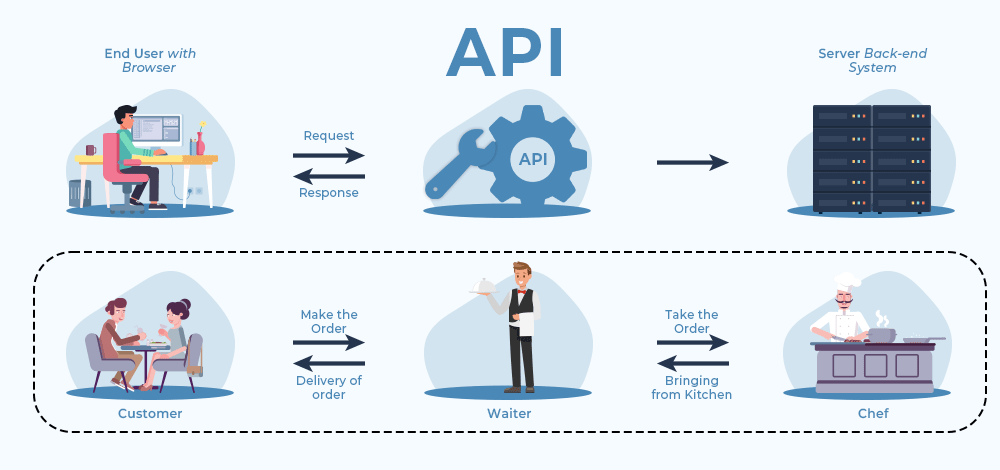API - Application Programming Interface
 OBULIPURUSOTHAMAN K
OBULIPURUSOTHAMAN K
APIs - Application Programming Interface
APIs are used for Communications
Abstraction hiding the implementation of process , ex if you hit the POST call its will go to the Server and its post the data but actually the POST doesn’t know the How its implementing in Server
Platform Agnostic – Service are written in the Different language and different platform can easily Communicate with each other using APIs
Examples / Use Cases of APIs
Private APIs – Hidden APIs that only an Applications running on your Device or Phone its access to not for public use Ex : Payment Apps
Public APIs - Its available for public Ex : Google Map
Web APIs – Super set of Public & Private APIs , The Application which running on Cloud can Interact with each other using Web APIs Ex : Instagram Post
SDK / Library APIs – Threating Library which expose the function like Lock , Release , Fork , Join we can use this APIs
API Factors :
API Contracts
Documentation
Data format
Security
API Standards
RPC
SOAP
REST
Here’s a comparison between RPC , SOAP , and REST APIs:
1. RPC (Remote Procedure Call)
Concept : RPC allows a program to execute procedures (methods or functions) on a remote server as if they were local calls. The server and client communicate using a specified protocol.
Protocol : Can use various protocols (e.g., HTTP, XML-RPC, JSON-RPC).
Message Format : Typically uses lightweight message formats like JSON or XML.
Usage : It is ideal for scenarios where you need direct method/function calls across different systems.
Pros :
Easy to understand and implement.
Suitable for microservices that need to expose simple function-based interactions.
Cons :
Tight coupling between client and server.
Less flexibility than REST.
2. SOAP (Simple Object Access Protocol)
Concept : SOAP is a protocol for exchanging structured information in web services. It uses XML to format the data and operates over various application layer protocols like HTTP, SMTP.
Protocol : Follows strict rules and standards (such as WS-Security, WS-AtomicTransaction, etc.).
Message Format : XML-based message structure.
Usage : Preferred in enterprise-level applications where security, ACID transactions, or complex operations are crucial (e.g., financial systems).
Pros :
Built-in standards for security, transactions, etc.
Works well with stateful operations.
Cons :
Heavyweight due to the extensive use of XML.
Slower performance compared to REST because of overhead.
3. REST (Representational State Transfer)
Concept : REST is an architectural style that uses standard HTTP methods (GET, POST, PUT, DELETE) for interacting with resources represented by URLs.
Protocol : Uses HTTP/HTTPS for communication.
Message Format : Flexible, often uses JSON or XML for data representation.
Usage : Widely used for web services due to its simplicity and scalability (e.g., CRUD operations).
Pros :
Lightweight and stateless.
Flexible and scalable.
Better performance than SOAP in most cases.
Cons :
No built-in standards for security and transactions (can be added separately).
May not be suitable for highly complex interactions.
Key Differences:
| Feature | RPC | SOAP | REST |
| Protocol | Various (e.g., JSON-RPC) | Strict (HTTP, SMTP) | HTTP/HTTPS |
| Message Format | JSON, XML | XML | JSON, XML, others |
| Coupling | Tight coupling | High (with strict rules) | Loose coupling |
| Complexity | Simple | Complex (many standards) | Simple and lightweight |
| Performance | Faster, lightweight | Slower due to overhead | Typically fast |
| Security | Depends on implementation | Built-in security (WS-Security) | External (e.g., OAuth, HTTPS) |
Each has its strengths, depending on the use case (e.g., SOAP for secure enterprise systems, REST for scalable web services, RPC for simple function calls).
Subscribe to my newsletter
Read articles from OBULIPURUSOTHAMAN K directly inside your inbox. Subscribe to the newsletter, and don't miss out.
Written by

OBULIPURUSOTHAMAN K
OBULIPURUSOTHAMAN K
As a Computer Science and Engineering graduate, I have cultivated a deep understanding of software development principles and technologies. With a strong foundation in Java programming, coupled with expertise in frontend and backend development, I thrive in crafting robust and scalable solutions. Currently, I am leveraging my skills as a Java Full Stack Engineer at Cognizant, where I am involved in designing and implementing end-to-end solutions that meet the complex requirements of our clients. I am passionate about leveraging emerging technologies to drive innovation and deliver tangible business value. My goal is to continually enhance my expertise and contribute to the advancement of software engineering practices in the industry.